无人机避障——4D毫米波雷达Octomap从点云建立三维栅格地图
Octomap安装
sudo apt-get install ros-melodic-octomap-ros
sudo apt-get install ros-melodic-octomap-msgs
sudo apt-get install ros-melodic-octomap-server
sudo apt-get install ros-melodic-octomap-rviz-plugins
# map_server安装
sudo apt-get install ros-melodic-map-server启动rviz
roscore
rosrun rviz rviz点击add,可以看到多了Octomap_rviz_plugins模组:
OccupancyGrid是显示三维概率地图,也就是octomap地图。OccupancyMap是显示二维占据栅格地图
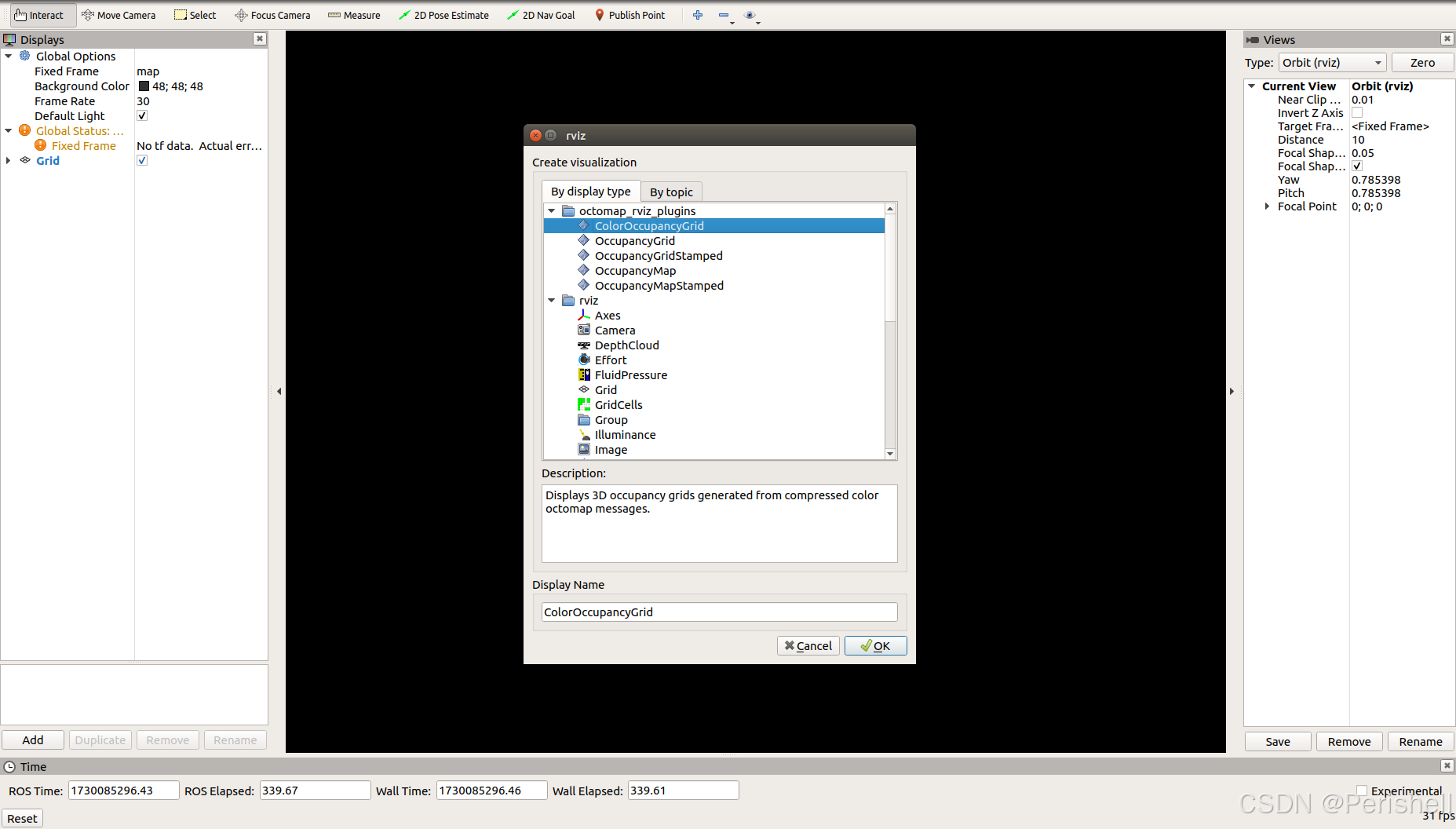
从PCD创建PointCloud2点云话题并发布出去:
参考资料:
测试的test数据采用以下第一条博客的pcd测试数据
Octomap 在ROS环境下实时显示_octomap在ros环境下实时显示-飞天熊猫-CSDN博客
学习笔记:使用Octomap将点云地图pcd转换为三维栅格地图,并在rviz中可视化_octomap功能包-CSDN博客
创建点云发布话题的工作空间:
mkdir -p ~/publish_pointcloudtest/src #使用系统命令创建工作空间目录
cd ~/publish_pointcloudtest/src
catkin_init_workspace # ROS的工作空间初始化命令
在工作空间下放入以下两个文件:
octomap_mapping
octomap_server
资源下载:
https://github.com/OctoMap/octomap_mapping
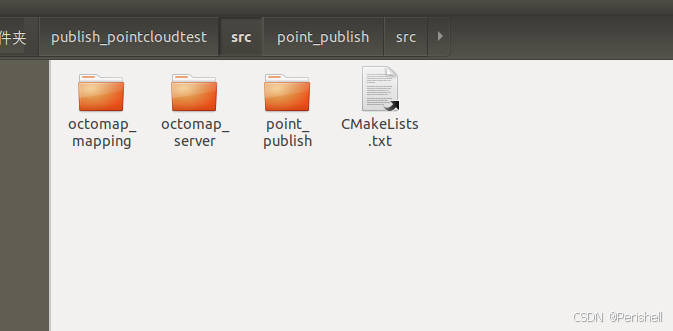
src下创建cpp文件pointcloud_publisher.cpp
#include <iostream>
#include <string>
#include <stdlib.h>
#include <stdio.h>
#include <sstream>
#include <vector>#include <ros/ros.h>
#include <pcl/point_cloud.h>
#include <pcl_conversions/pcl_conversions.h>
#include <sensor_msgs/PointCloud2.h>
#include <pcl/io/pcd_io.h>#include <octomap_msgs/OctomapWithPose.h>
#include <octomap_msgs/Octomap.h>
#include <geometry_msgs/Pose.h>#include <octomap/octomap.h>
#include <octomap_msgs/Octomap.h>
#include <octomap_msgs/conversions.h>#include <geometry_msgs/TransformStamped.h>#define TESTCLOUDPOINTS 1 // 设置为 1 以测试点云发布,设置为 0 不测试
#define TESTOCTOTREE 0 // 设置为 1 以测试OctoMap发布,设置为 0 不测试int main (int argc, char **argv)
{ std::string topic, path, frame_id;int hz = 5; // 发布频率,单位 Hzros::init(argc, argv, "publish_pointcloud"); // 初始化ROS节点ros::NodeHandle nh; // 创建节点句柄// 从参数服务器获取参数nh.param<std::string>("path", path, "/home/nvidia/publish_pointcloudtest/data/test.pcd");nh.param<std::string>("frame_id", frame_id, "map");nh.param<std::string>("topic", topic, "pointcloud_topic");nh.param<int>("hz", hz, 5);// 加载点云数据到pcl::PointCloud对象中pcl::PointCloud<pcl::PointXYZ> pcl_cloud; pcl::io::loadPCDFile(path, pcl_cloud); // 从文件加载点云数据#if TESTCLOUDPOINTS // 如果 TESTCLOUDPOINTS 定义为 1,则执行这部分代码ros::Publisher pcl_pub = nh.advertise<sensor_msgs::PointCloud2>(topic, 10); // 创建Publisher对象,将点云数据发布到指定话题// 转换PCL点云到ROS下的 PointCloud2 类型sensor_msgs::PointCloud2 output; pcl::toROSMsg(pcl_cloud, output);output.header.stamp = ros::Time::now(); // 设置时间戳output.header.frame_id = frame_id; // 设置坐标系框架// 打印参数信息std::cout << "path = " << path << std::endl;std::cout << "frame_id = " << frame_id << std::endl;std::cout << "topic = " << topic << std::endl;std::cout << "hz = " << hz << std::endl;ros::Rate loop_rate(hz); // 设置发布频率 while (ros::ok()) { pcl_pub.publish(output); // 发布 PointCloud2 数据ros::spinOnce(); // 处理所有回调函数loop_rate.sleep(); // 按照指定频率睡眠}
#endif#if TESTOCTOTREE // 如果 TESTOCTOTREE 定义为 1,则执行这部分代码ros::Publisher octomap_pub = nh.advertise<octomap_msgs::Octomap>(topic, 1); // 创建Publisher对象,将OctoMap数据发布到指定话题// 创建 octomap 对象,并设置其分辨率octomap::OcTree tree(0.1); // 你可以根据需要调整分辨率// 将点云数据插入到 octomap 中for (const auto& point : pcl_cloud.points) {tree.updateNode(point.x, point.y, point.z, true);}// 发布OctoMap消息octomap_msgs::Octomap octomap_msg;octomap_msgs::fullMapToMsg(tree, octomap_msg); // 转换为 OctoMap 消息// 设置 OctoMap 消息的头信息octomap_msg.header.stamp = ros::Time::now();octomap_msg.header.frame_id = frame_id;// 打印参数信息std::cout << "path = " << path << std::endl;std::cout << "frame_id = " << frame_id << std::endl;std::cout << "topic = " << topic << std::endl;std::cout << "hz = " << hz << std::endl;ros::Rate loop_rate(hz); // 设置发布频率 while (ros::ok()) { octomap_pub.publish(octomap_msg); // 发布 OctoMap 数据ros::spinOnce(); // 处理所有回调函数loop_rate.sleep(); // 按照指定频率睡眠}
#endifreturn 0; // 主函数返回值
}代码中需要进行修改为自己的点云,后续相应都需要修改为自己的路径(自行修改):
nh.param<std::string>("path", path, "/home/nvidia/publish_pointcloudtest/data/test.pcd");CMakeLists.txt
cmake_minimum_required(VERSION 3.0.2)
project(publish_pointcloud)## Compile as C++11, supported in ROS Kinetic and newer
# add_compile_options(-std=c++11)## Find catkin macros and libraries
## if COMPONENTS list like find_package(catkin REQUIRED COMPONENTS xyz)
## is used, also find other catkin packagesset(octomap_ros_DIR "/opt/ros/melodic/share/octomap_ros/cmake")find_package(catkin REQUIRED COMPONENTSroscppstd_msgssensor_msgsoctomap_msgsgeometry_msgsoctomap_ros
)
find_package(PCL REQUIRED)
find_package(octomap REQUIRED)## System dependencies are found with CMake's conventions
# find_package(Boost REQUIRED COMPONENTS system)## Uncomment this if the package has a setup.py. This macro ensures
## modules and global scripts declared therein get installed
## See http://ros.org/doc/api/catkin/html/user_guide/setup_dot_py.html
# catkin_python_setup()################################################
## Declare ROS messages, services and actions ##
################################################## To declare and build messages, services or actions from within this
## package, follow these steps:
## * Let MSG_DEP_SET be the set of packages whose message types you use in
## your messages/services/actions (e.g. std_msgs, actionlib_msgs, ...).
## * In the file package.xml:
## * add a build_depend tag for "message_generation"
## * add a build_depend and a exec_depend tag for each package in MSG_DEP_SET
## * If MSG_DEP_SET isn't empty the following dependency has been pulled in
## but can be declared for certainty nonetheless:
## * add a exec_depend tag for "message_runtime"
## * In this file (CMakeLists.txt):
## * add "message_generation" and every package in MSG_DEP_SET to
## find_package(catkin REQUIRED COMPONENTS ...)
## * add "message_runtime" and every package in MSG_DEP_SET to
## catkin_package(CATKIN_DEPENDS ...)
## * uncomment the add_*_files sections below as needed
## and list every .msg/.srv/.action file to be processed
## * uncomment the generate_messages entry below
## * add every package in MSG_DEP_SET to generate_messages(DEPENDENCIES ...)## Generate messages in the 'msg' folder
# add_message_files(
# FILES
# Message1.msg
# Message2.msg
# )## Generate services in the 'srv' folder
# add_service_files(
# FILES
# Service1.srv
# Service2.srv
# )## Generate actions in the 'action' folder
# add_action_files(
# FILES
# Action1.action
# Action2.action
# )## Generate added messages and services with any dependencies listed here
# generate_messages(
# DEPENDENCIES
# std_msgs
# )################################################
## Declare ROS dynamic reconfigure parameters ##
################################################## To declare and build dynamic reconfigure parameters within this
## package, follow these steps:
## * In the file package.xml:
## * add a build_depend and a exec_depend tag for "dynamic_reconfigure"
## * In this file (CMakeLists.txt):
## * add "dynamic_reconfigure" to
## find_package(catkin REQUIRED COMPONENTS ...)
## * uncomment the "generate_dynamic_reconfigure_options" section below
## and list every .cfg file to be processed## Generate dynamic reconfigure parameters in the 'cfg' folder
# generate_dynamic_reconfigure_options(
# cfg/DynReconf1.cfg
# cfg/DynReconf2.cfg
# )###################################
## catkin specific configuration ##
###################################
## The catkin_package macro generates cmake config files for your package
## Declare things to be passed to dependent projects
## INCLUDE_DIRS: uncomment this if your package contains header files
## LIBRARIES: libraries you create in this project that dependent projects also need
## CATKIN_DEPENDS: catkin_packages dependent projects also need
## DEPENDS: system dependencies of this project that dependent projects also need
catkin_package(
# INCLUDE_DIRS include
# LIBRARIES my_pkg
# CATKIN_DEPENDS roscpp std_msgs
# DEPENDS system_lib
)###########
## Build ##
############# Specify additional locations of header files
## Your package locations should be listed before other locations
include_directories(
# include${catkin_INCLUDE_DIRS}${PCL_INCLUDE_DIRS}${OCTOMAP_INCLUDE_DIRS}
)## Declare a C++ library
# add_library(${PROJECT_NAME}
# src/${PROJECT_NAME}/my_pkg.cpp
# )## Add cmake target dependencies of the library
## as an example, code may need to be generated before libraries
## either from message generation or dynamic reconfigure
# add_dependencies(${PROJECT_NAME} ${${PROJECT_NAME}_EXPORTED_TARGETS} ${catkin_EXPORTED_TARGETS})## Declare a C++ executable
## With catkin_make all packages are built within a single CMake context
## The recommended prefix ensures that target names across packages don't collide
add_executable(publish_pointcloud src/pointcloud_publisher.cpp)## Rename C++ executable without prefix
## The above recommended prefix causes long target names, the following renames the
## target back to the shorter version for ease of user use
## e.g. "rosrun someones_pkg node" instead of "rosrun someones_pkg someones_pkg_node"
# set_target_properties(${PROJECT_NAME}_node PROPERTIES OUTPUT_NAME node PREFIX "")## Add cmake target dependencies of the executable
## same as for the library above
# add_dependencies(${PROJECT_NAME}_node ${${PROJECT_NAME}_EXPORTED_TARGETS} ${catkin_EXPORTED_TARGETS})## Specify libraries to link a library or executable target against
target_link_libraries(publish_pointcloud${catkin_LIBRARIES}${PCL_LIBRARIES}${OCTOMAP_LIBRARIES}
)#############
## Install ##
############## all install targets should use catkin DESTINATION variables
# See http://ros.org/doc/api/catkin/html/adv_user_guide/variables.html## Mark executable scripts (Python etc.) for installation
## in contrast to setup.py, you can choose the destination
# catkin_install_python(PROGRAMS
# scripts/my_python_script
# DESTINATION ${CATKIN_PACKAGE_BIN_DESTINATION}
# )## Mark executables for installation
## See http://docs.ros.org/melodic/api/catkin/html/howto/format1/building_executables.html
# install(TARGETS ${PROJECT_NAME}_node
# RUNTIME DESTINATION ${CATKIN_PACKAGE_BIN_DESTINATION}
# )## Mark libraries for installation
## See http://docs.ros.org/melodic/api/catkin/html/howto/format1/building_libraries.html
# install(TARGETS ${PROJECT_NAME}
# ARCHIVE DESTINATION ${CATKIN_PACKAGE_LIB_DESTINATION}
# LIBRARY DESTINATION ${CATKIN_PACKAGE_LIB_DESTINATION}
# RUNTIME DESTINATION ${CATKIN_GLOBAL_BIN_DESTINATION}
# )## Mark cpp header files for installation
# install(DIRECTORY include/${PROJECT_NAME}/
# DESTINATION ${CATKIN_PACKAGE_INCLUDE_DESTINATION}
# FILES_MATCHING PATTERN "*.h"
# PATTERN ".svn" EXCLUDE
# )## Mark other files for installation (e.g. launch and bag files, etc.)
# install(FILES
# # myfile1
# # myfile2
# DESTINATION ${CATKIN_PACKAGE_SHARE_DESTINATION}
# )#############
## Testing ##
############### Add gtest based cpp test target and link libraries
# catkin_add_gtest(${PROJECT_NAME}-test test/test_my_pkg.cpp)
# if(TARGET ${PROJECT_NAME}-test)
# target_link_libraries(${PROJECT_NAME}-test ${PROJECT_NAME})
# endif()## Add folders to be run by python nosetests
# catkin_add_nosetests(test)package.xml
<?xml version="1.0"?>
<package format="2"><name>publish_pointcloud</name><version>0.0.0</version><description>The publish_pointcloud package</description><!-- One maintainer tag required, multiple allowed, one person per tag --><!-- Example: --><!-- <maintainer email="jane.doe@example.com">Jane Doe</maintainer> --><maintainer email="nvidia@todo.todo">nvidia</maintainer><!-- One license tag required, multiple allowed, one license per tag --><!-- Commonly used license strings: --><!-- BSD, MIT, Boost Software License, GPLv2, GPLv3, LGPLv2.1, LGPLv3 --><license>TODO</license><!-- Url tags are optional, but multiple are allowed, one per tag --><!-- Optional attribute type can be: website, bugtracker, or repository --><!-- Example: --><!-- <url type="website">http://wiki.ros.org/point_publish</url> --><!-- Author tags are optional, multiple are allowed, one per tag --><!-- Authors do not have to be maintainers, but could be --><!-- Example: --><!-- <author email="jane.doe@example.com">Jane Doe</author> --><!-- The *depend tags are used to specify dependencies --><!-- Dependencies can be catkin packages or system dependencies --><!-- Examples: --><!-- Use depend as a shortcut for packages that are both build and exec dependencies --><!-- <depend>roscpp</depend> --><!-- Note that this is equivalent to the following: --><!-- <build_depend>roscpp</build_depend> --><!-- <exec_depend>roscpp</exec_depend> --><!-- Use build_depend for packages you need at compile time: --><!-- <build_depend>message_generation</build_depend> --><!-- Use build_export_depend for packages you need in order to build against this package: --><!-- <build_export_depend>message_generation</build_export_depend> --><!-- Use buildtool_depend for build tool packages: --><!-- <buildtool_depend>catkin</buildtool_depend> --><!-- Use exec_depend for packages you need at runtime: --><!-- <exec_depend>message_runtime</exec_depend> --><!-- Use test_depend for packages you need only for testing: --><!-- <test_depend>gtest</test_depend> --><!-- Use doc_depend for packages you need only for building documentation: --><!-- <doc_depend>doxygen</doc_depend> --><buildtool_depend>catkin</buildtool_depend><build_depend>roscpp</build_depend><build_depend>std_msgs</build_depend><build_export_depend>roscpp</build_export_depend><build_export_depend>std_msgs</build_export_depend><exec_depend>roscpp</exec_depend><exec_depend>std_msgs</exec_depend><!-- The export tag contains other, unspecified, tags --><export><!-- Other tools can request additional information be placed here --></export>
</package>编译通过
记得在devel那边进行source
source devel/setup.bash
roscore
rosrun publish_pointcloud publish_pointcloud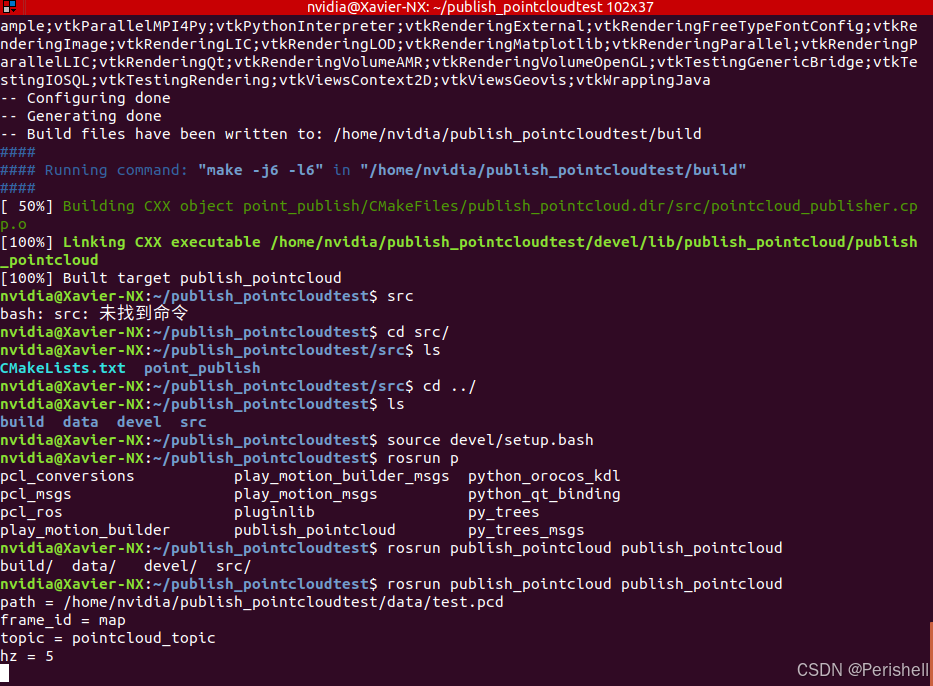
查看下是否有话题,且可以打印出来
rostopic list
rostopic echo /pointcloud_topic 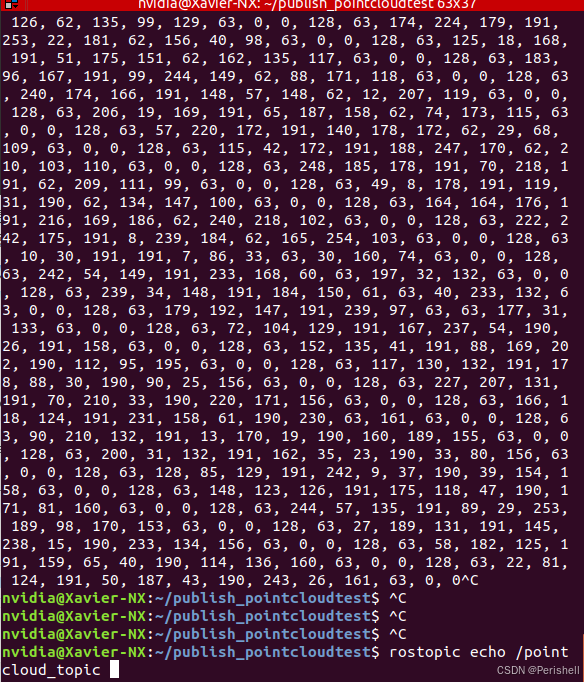
然后打开终端打开rviz
rviz将PointCloud2 添加进来,话题选择之前的点云话题
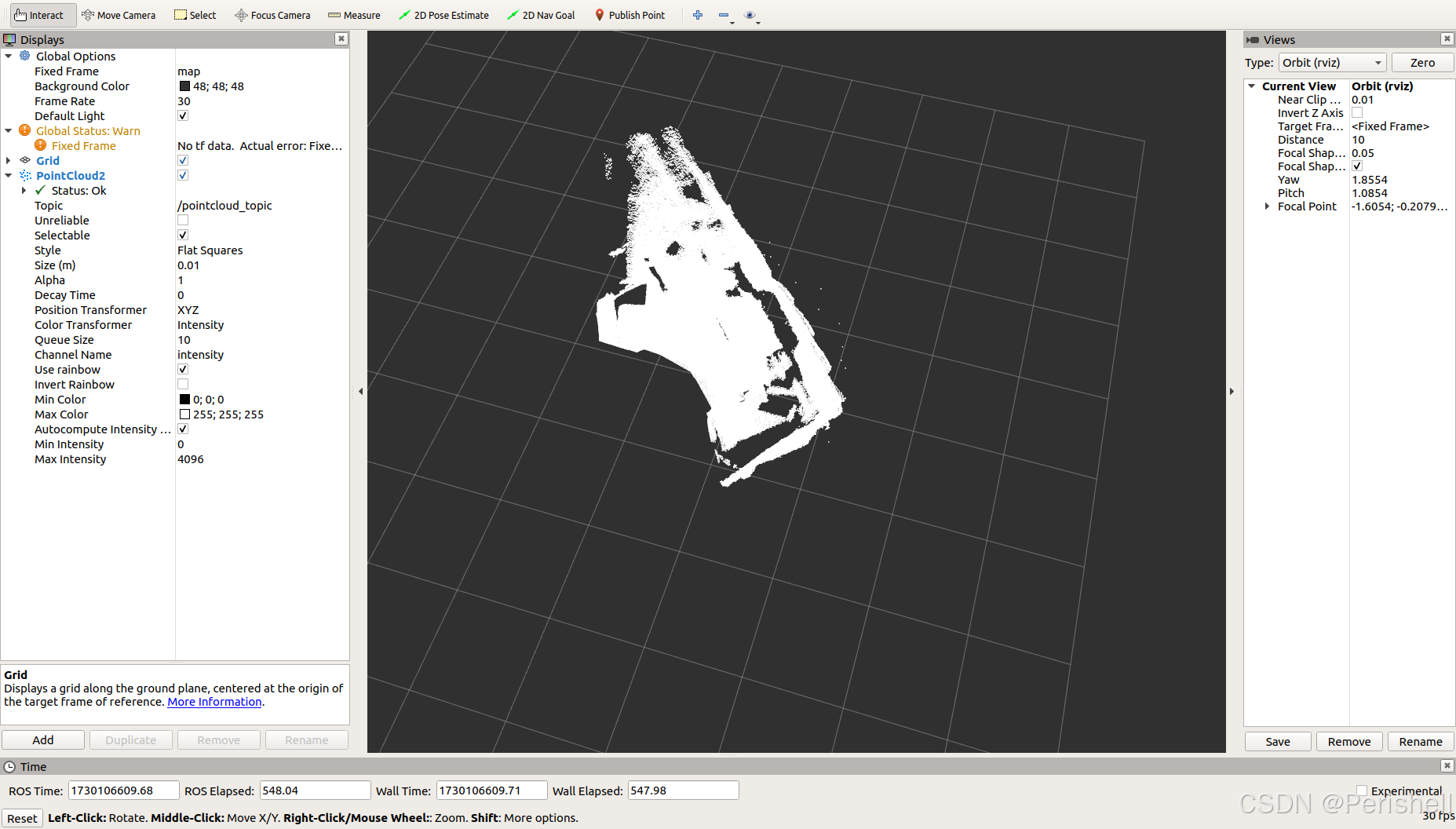
编写octomap_mapping.launch文件,launch文件在:

将frameid修改即可
<launch><node pkg="octomap_server" type="octomap_server_node" name="octomap_server"><param name="resolution" value="0.05" /><!-- fixed map frame (set to 'map' if SLAM or localization running!) --><param name="frame_id" type="string" value="map" /><!-- maximum range to integrate (speedup!) --><param name="sensor_model/max_range" value="5.0" /><!-- data source to integrate (PointCloud2) --><remap from="cloud_in" to="/pointcloud_topic" /></node>
</launch>然后就可以运行launch文件了:
roslaunch octomap_server octomap_mapping.launch总结上面所有的过程 :
1、改完代码后编译nvidia@Xavier-NX:~/publish_pointcloudtest$ catkin_make2、编译完后roscorenvidia@Xavier-NX:~$ roscore3、运行点云发布代码nvidia@Xavier-NX:~/publish_pointcloudtest$ rosrun publish_pointcloud publish_pointcloud4、运行rviz使其显示白色的点云nvidia@Xavier-NX:~$ rviz5、运行octomapnvidia@Xavier-NX:~/publish_pointcloudtest$ roslaunch octomap_server octomap_mapping.launch上面的点云也是可以测试出来的,如第一张的图,最后用的自己4D毫米波雷达生成的点云也进行了测试,不过有些点云没能显示,后续还需要改进,估计跟坐标系的范围也有关系:
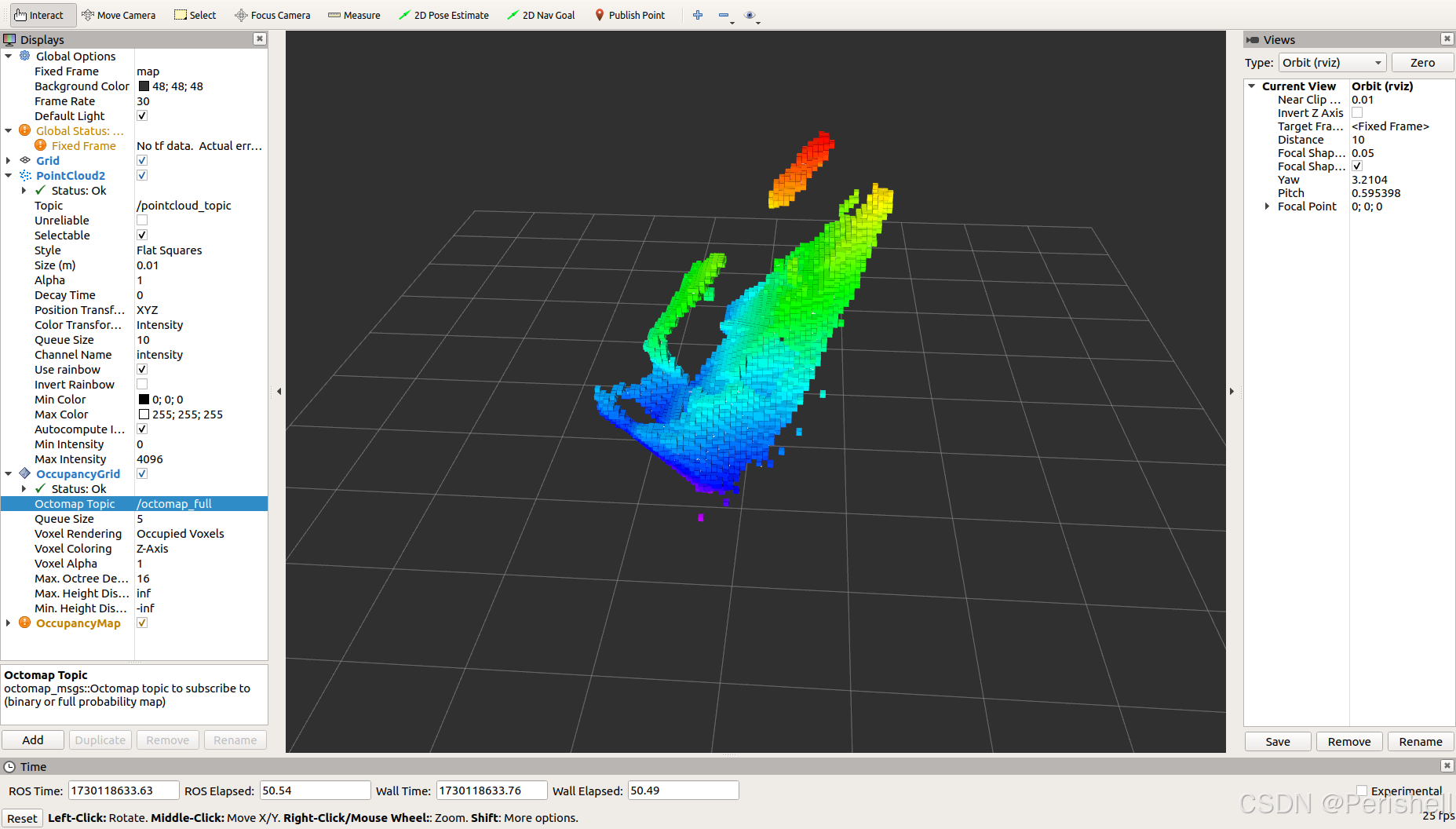
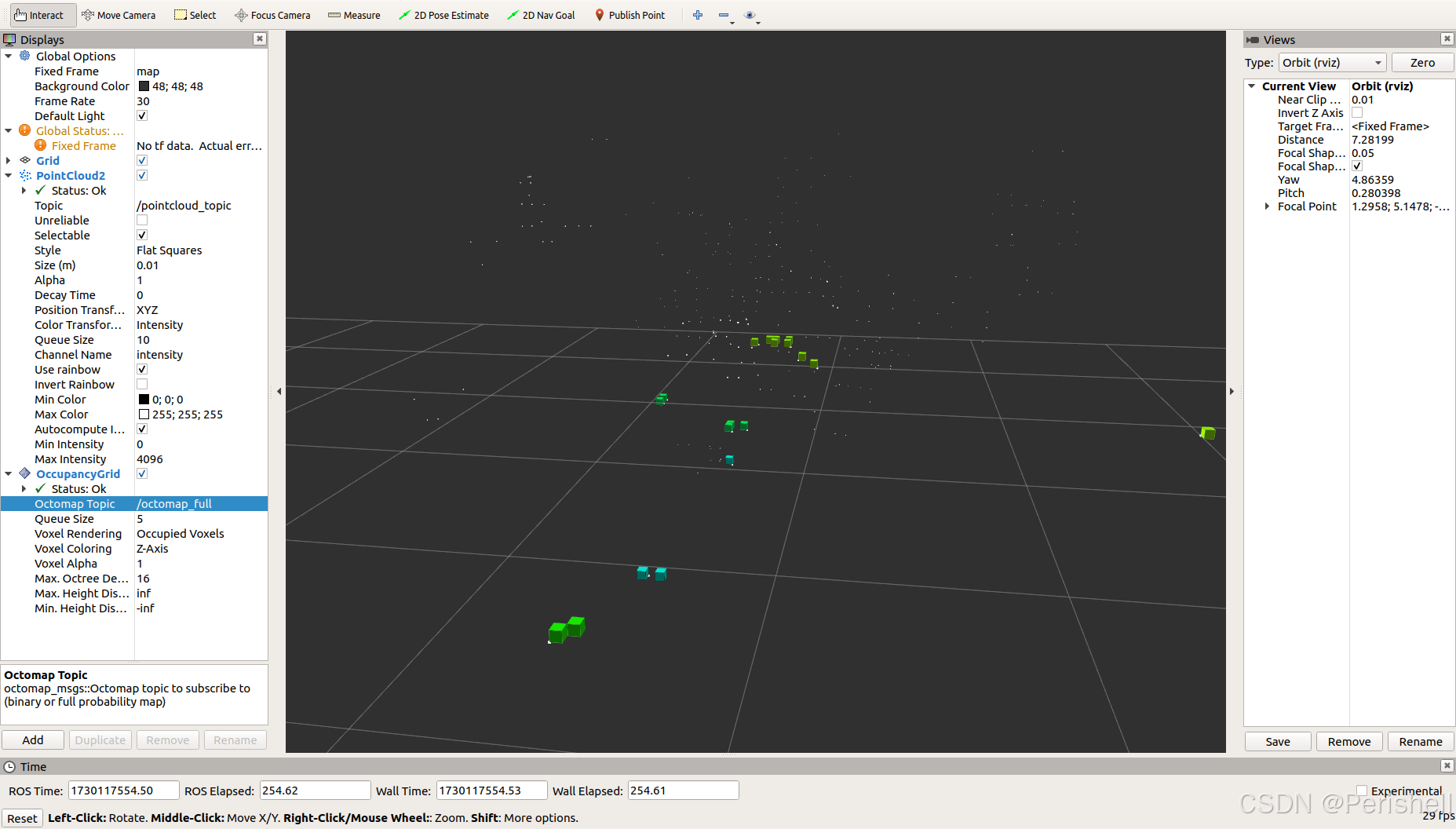
后续考虑实时动态,以及将其转换为二维栅格地图作为无人机的导航地图。
相关文章:

无人机避障——4D毫米波雷达Octomap从点云建立三维栅格地图
Octomap安装 sudo apt-get install ros-melodic-octomap-ros sudo apt-get install ros-melodic-octomap-msgs sudo apt-get install ros-melodic-octomap-server sudo apt-get install ros-melodic-octomap-rviz-plugins # map_server安装 sudo apt-get install ros-melodic-…...

Python(数据结构2)
常见数据结构 队列 队列(Queue),它是一种运算受限的线性表,先进先出(FIFO First In First Out) Python标准库中的queue模块提供了多种队列实现,包括普通队列、双端队列、优先队列等。 1 普通队列 queue.Queue 是 Python 标准库 queue 模块中的一个类…...

深入解析HTTP与HTTPS的区别及实现原理
文章目录 引言HTTP协议基础HTTP响应 HTTPS协议SSL/TLS协议 总结参考资料 引言 HTTP(HyperText Transfer Protocol)超文本传输协议是用于从Web服务器传输超文本到本地浏览器的主要协议。随着网络安全意识的提高,HTTPS(HTTP Secure…...

Java IO 模型
I/O 何为 I/O? I/O(Input/Output) 即输入/输出 。 我们先从计算机结构的角度来解读一下 I/O。 根据冯.诺依曼结构,计算机结构分为 5 大部分:运算器、控制器、存储器、输入设备、输出设备。 输入设备(比…...

安装双系统后ubuntu无法联网(没有wifi标识)网卡驱动为RTL8852BE
安装双系统后ubuntu没有办法联网,(本篇博客适用的版本为ubuntu20.04)且针对情况为无线网卡驱动未安装的情况 此时没有网络,可以使用手机数据线连接,使用USB共享网络便可解决无法下载的问题。 打开终端使用命令lshw -C …...

Sqoop的安装配置及使用
Sqoop安装前需要检查之前是否安装了Tez,否则会产生版本或依赖冲突,我们需要移除tez-site.xml,并将hadoop中的mapred-site.xml配置文件中的mapreduce驱动改回成yarn,然后分发到其他节点,hive里面配置的tez也要移除,然后…...

R语言机器学习算法实战系列(十三)随机森林生存分析构建预后模型 (Random Survival Forest)
禁止商业或二改转载,仅供自学使用,侵权必究,如需截取部分内容请后台联系作者! 文章目录 介绍教程加载R包案例数据数据预处理数据描述构建randomForestSRC模型评估模型C-indexBrier score特征重要性构建新的随机森林生存模型风险打分高低风险分组的生存分析时间依赖的ROC(Ti…...

三款计算服务器配置→如何选择科学计算服务器?
科学计算在众多领域都扮演着关键角色,无论是基础科学研究还是实际工程应用,强大的计算能力都是不可或缺的。而选择一台合适的科学计算服务器,对于确保科研和工作的顺利进行至关重要。 首先,明确自身需求是重中之重。要仔细考虑计算…...

Oracle 19c RAC删除多余的PDB的方式
文章目录 一、删除PDB并删除数据文件二、删除PDB并保留数据文件三、插拔PDB 一、删除PDB并删除数据文件 所删除的pdb必须是mount的状态才可以删除: #1、关闭pdb alter pluggable database pdb_name close immediate instancesall; #2、删除pdb以及数据文件 drop p…...
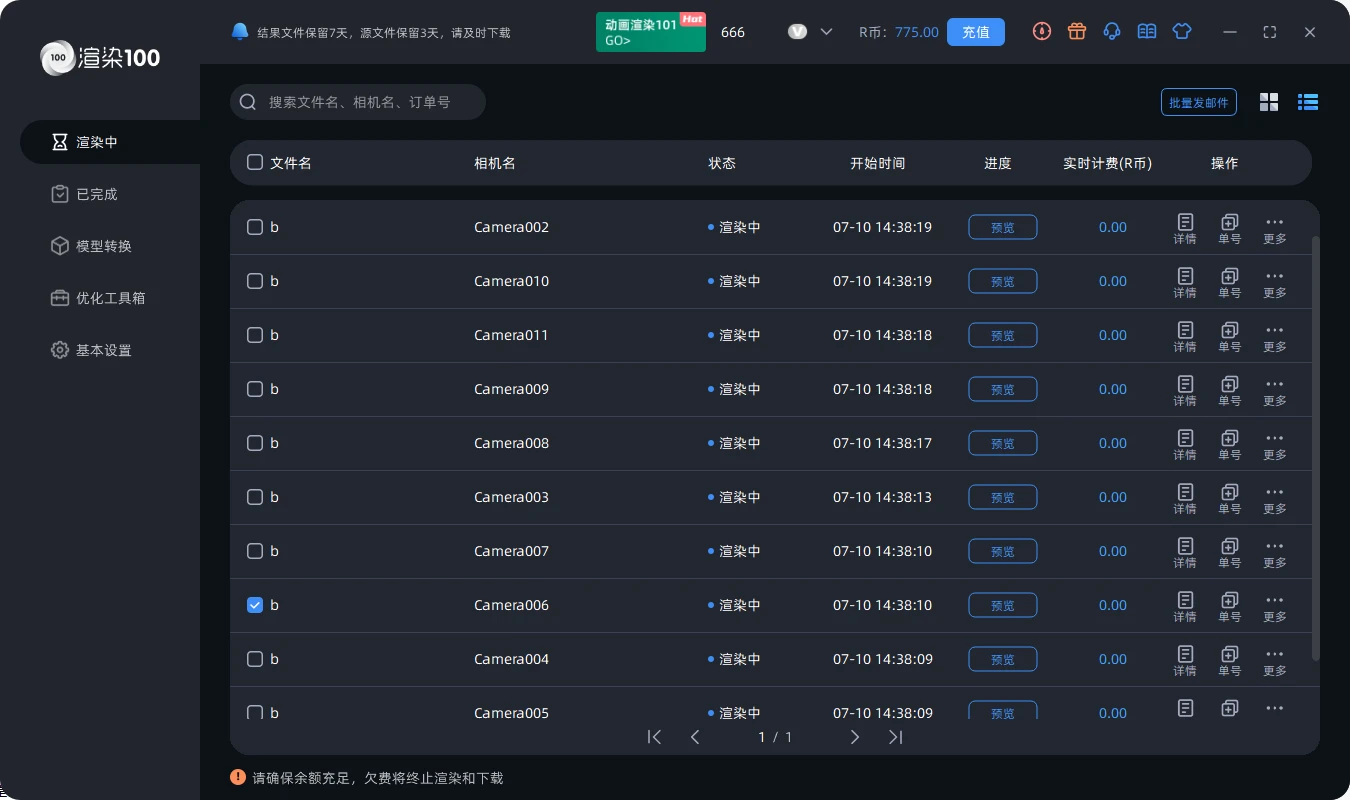
什么是云渲染?云渲染有什么用?一篇看懂云渲染意思
你知道云渲染是怎么回事吗? 其实就是把3D模型变成2D图像的过程,只不过这个过程是在云端完成的。我们在本地啥都不用做,只需要等结果就行。 现在云渲染主要有两种类型:一种是物理机房云渲染,另一种是服务器机房云渲染。…...

MATLAB中 exist函数用法
目录 语法 说明 示例 检查工作区变量是否存在 检查文件夹是否存在 检查 MATLAB 函数是否为内置函数 exist函数的功能是检查变量、脚本、函数、文件夹或类的存在情况。 语法 exist name exist name searchType A exist(___) 说明 exist name 以数字形式返回 name 的类…...

在银河麒麟系统中Qt连接达梦数据库
解决在银河麒麟系统中使用Qt连接达梦数据库提示:project Error library odbc is not defined问题 一、编译ODBC 下载解压unixODBC(http://www.unixodbc.org/unixODBC-2.3.1.tar.gz) 打开终端,切换到unixODBC-2.3.1目录下&#x…...

nodejs 服务器实现负载均衡
server.js const express require(express); const { createProxyMiddleware } require(http-proxy-middleware); const axios require(axios);const app express();// 定义后端服务列表 const services [{ target: http://localhost:3001 },{ target: http://localhost:…...

今日总结10.29
常见序列化协议有哪些 序列化(serialization)是将对象序列化为二进制形式(字节数组),一般也将序列化称为编码(Encode),主要用于网络传输、数据持久化等。常见的序列化协议包括以下几…...
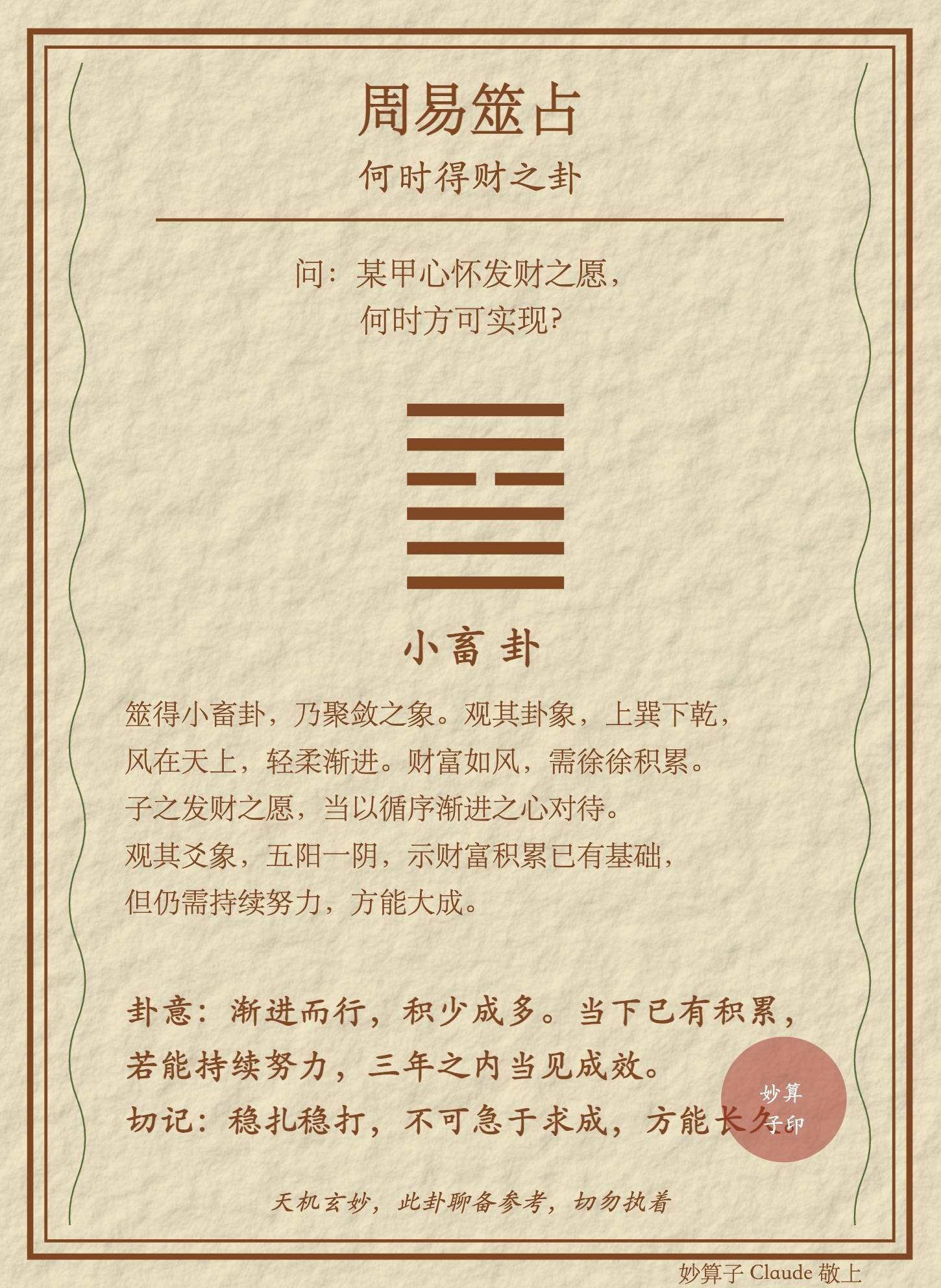
使用 FastGPT 工作流实现 AI 赛博算卦,一键生成卦象图
最近那个男人写的汉语新解火遍了全网,那个男人叫李继刚,国内玩 AI 的同学如果不知道这个名字,可以去面壁思过了。 这个汉语新解的神奇之处就在于它只是一段几百字的提示词,效果却顶得上几千行代码写出来的应用程序。 这段提示词…...

vue3+ts实时播放视频,视频分屏
使用vue3以及播放视频组件Jessibuca Jessibuca地址 使用循环个数来实现分屏 效果图,四屏 九屏 dom代码 <div class"icon"><div class"icon-box"><span class"text">分屏:</span><el-icon …...

【网页设计】学成在线案例
Demo 典型的企业级网站,目的是为了整体感知企业级网站的布局流程,复习以前知识。 集合代码见文章最后。 5.1 准备素材和工具 学成在线 PSD 源文件。开发工具 PS(切图) sublime(代码) chrome࿰…...

一篇文章总结 SQL 基础知识点
1. 官方文档 MySQL:https://dev.mysql.com/doc/refman/8.4/en/ SQL Server:What is SQL Server? - SQL Server | Microsoft Learn Oracle:https://docs.oracle.com/en/database/oracle/oracle-database/23/lnpls/loe.html 2. 术语 SQL S…...

vue Element U 解决表格数据不更新问题
最近在使用 Vue 和 Element UI 开发后台管理系统时,操作表单数据重新请求表格接口后遇到表格数据不更新的问题。后面查阅了些资料,这通常是由于 Vue 的响应式系统没有检测到数据的变化,或者数据更新后没有正确地触发视图的重新渲染。以下是一…...

PeView 命令行PE文件解析工具
PeView 是一款基于C/C开发的命令行版PE文件解析工具,专门用于解析Windows可执行文件并提供详尽的文件结构和交互式查询功能,帮助用户理解和分析目标程序的内部构成,是逆向分析和软件调试中的重要工具,本次分享工具源代码及使用方法…...
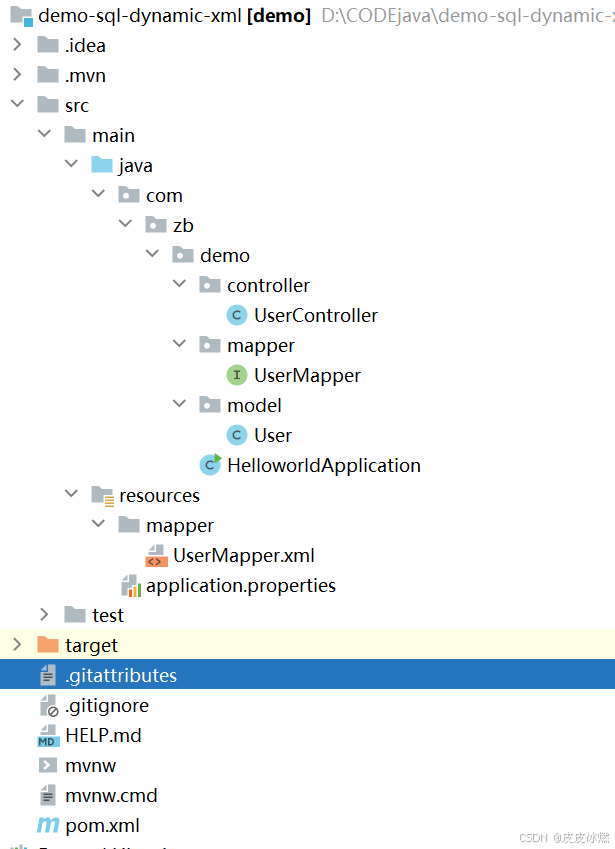
SpringBoot-17-MyBatis动态SQL标签之常用标签
文章目录 1 代码1.1 实体User.java1.2 接口UserMapper.java1.3 映射UserMapper.xml1.3.1 标签if1.3.2 标签if和where1.3.3 标签choose和when和otherwise1.4 UserController.java2 常用动态SQL标签2.1 标签set2.1.1 UserMapper.java2.1.2 UserMapper.xml2.1.3 UserController.ja…...
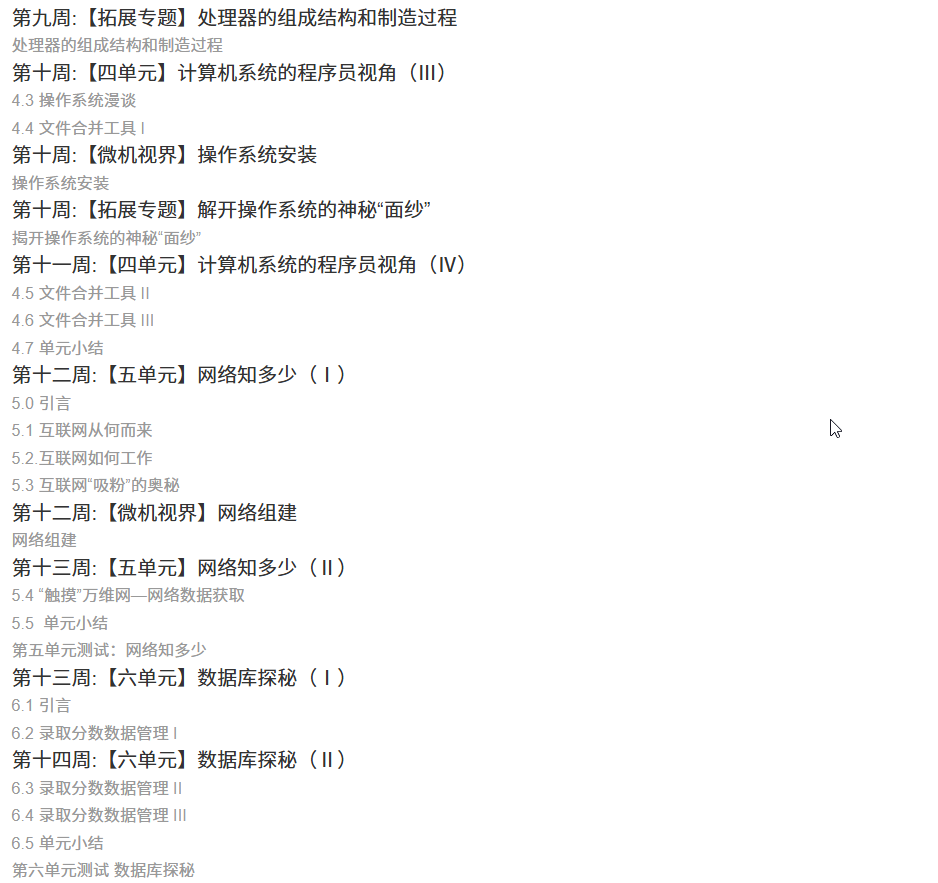
国防科技大学计算机基础课程笔记02信息编码
1.机内码和国标码 国标码就是我们非常熟悉的这个GB2312,但是因为都是16进制,因此这个了16进制的数据既可以翻译成为这个机器码,也可以翻译成为这个国标码,所以这个时候很容易会出现这个歧义的情况; 因此,我们的这个国…...
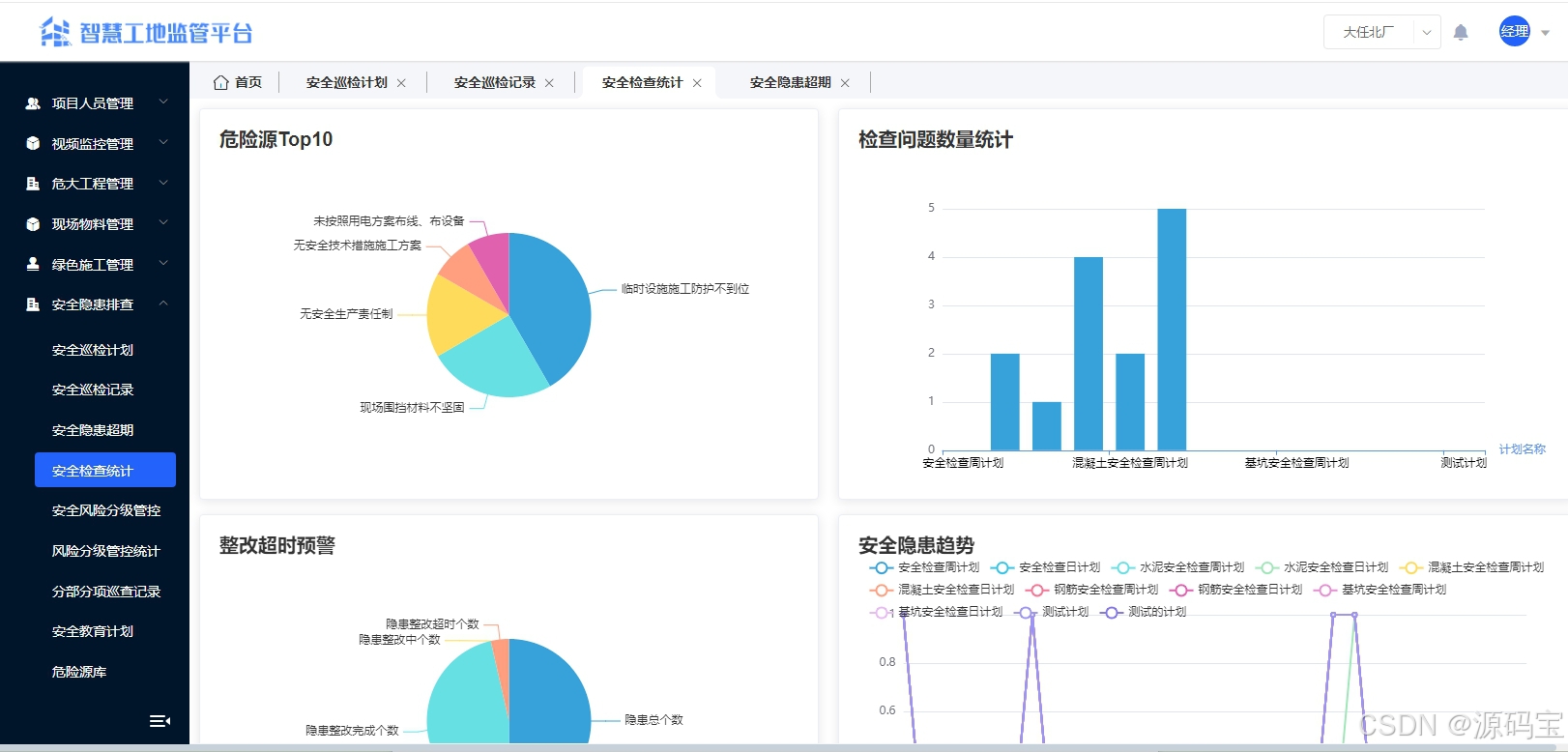
智慧工地云平台源码,基于微服务架构+Java+Spring Cloud +UniApp +MySql
智慧工地管理云平台系统,智慧工地全套源码,java版智慧工地源码,支持PC端、大屏端、移动端。 智慧工地聚焦建筑行业的市场需求,提供“平台网络终端”的整体解决方案,提供劳务管理、视频管理、智能监测、绿色施工、安全管…...
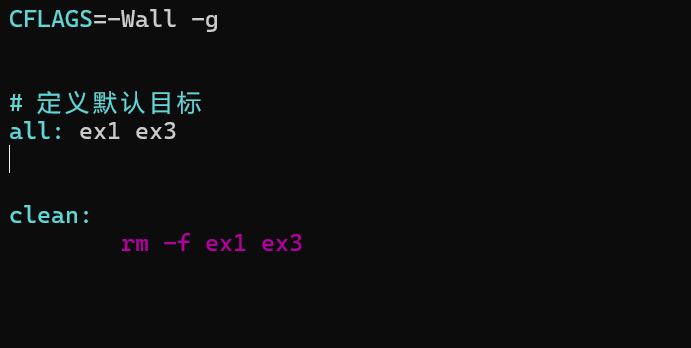
YSYX学习记录(八)
C语言,练习0: 先创建一个文件夹,我用的是物理机: 安装build-essential 练习1: 我注释掉了 #include <stdio.h> 出现下面错误 在你的文本编辑器中打开ex1文件,随机修改或删除一部分,之后…...
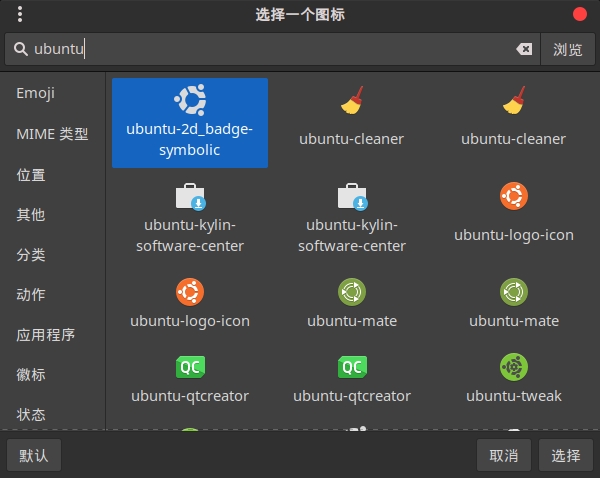
Cinnamon修改面板小工具图标
Cinnamon开始菜单-CSDN博客 设置模块都是做好的,比GNOME简单得多! 在 applet.js 里增加 const Settings imports.ui.settings;this.settings new Settings.AppletSettings(this, HTYMenusonichy, instance_id); this.settings.bind(menu-icon, menu…...
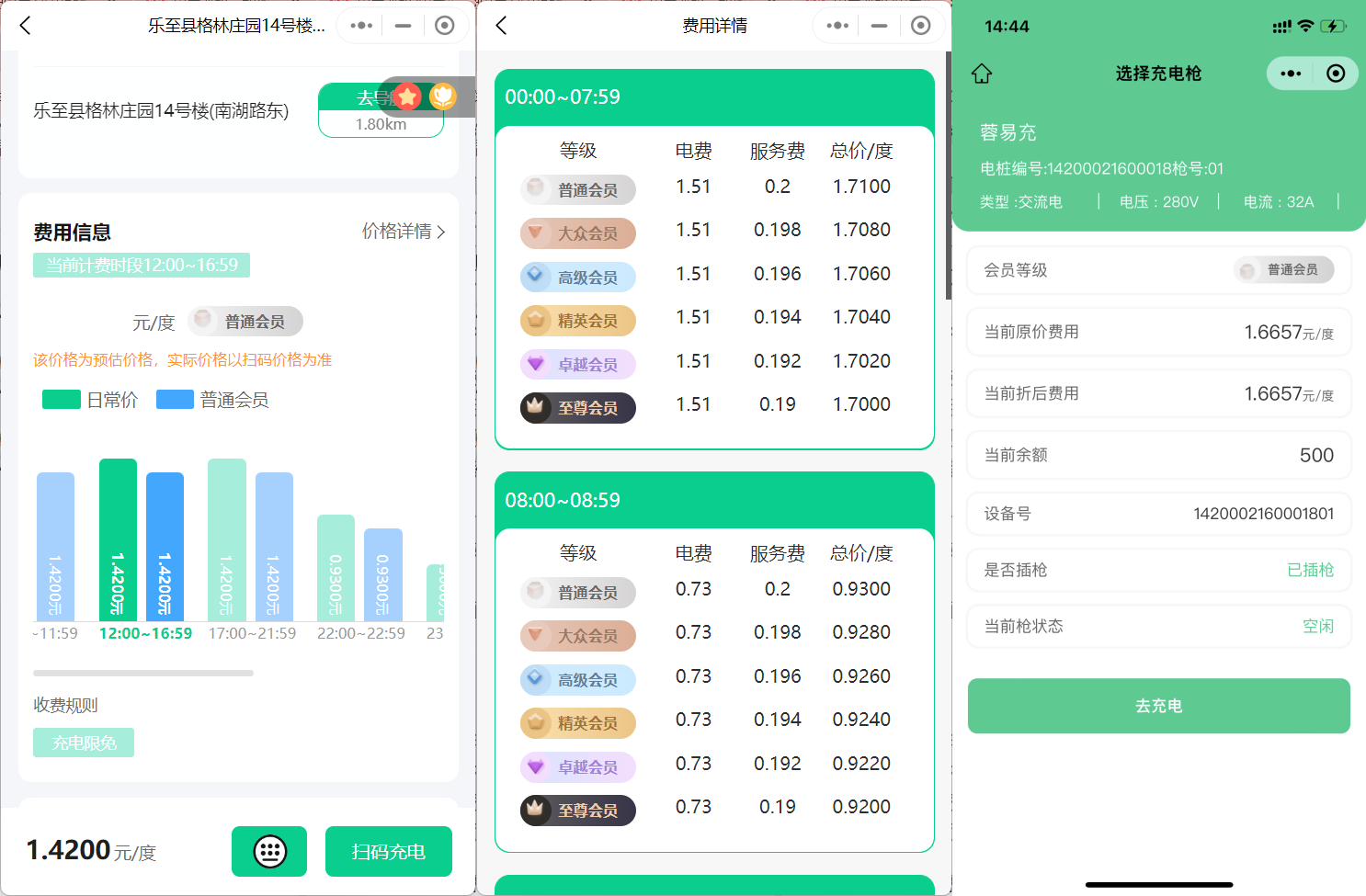
新能源汽车智慧充电桩管理方案:新能源充电桩散热问题及消防安全监管方案
随着新能源汽车的快速普及,充电桩作为核心配套设施,其安全性与可靠性备受关注。然而,在高温、高负荷运行环境下,充电桩的散热问题与消防安全隐患日益凸显,成为制约行业发展的关键瓶颈。 如何通过智慧化管理手段优化散…...
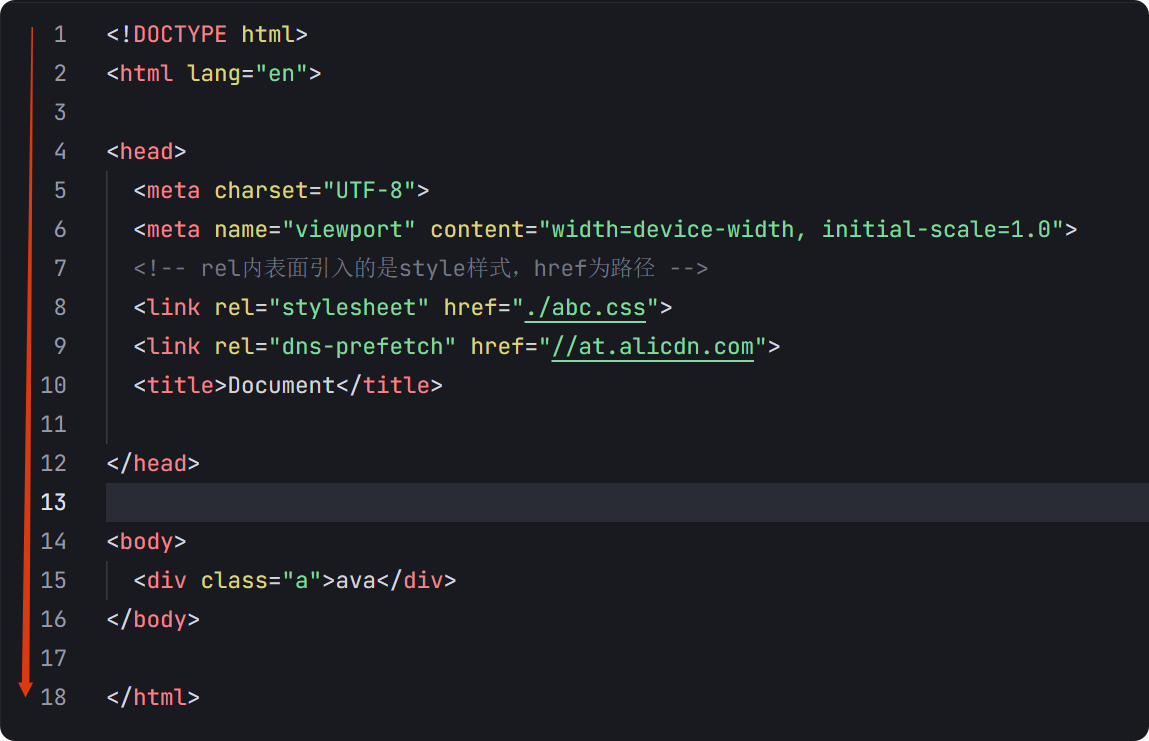
04-初识css
一、css样式引入 1.1.内部样式 <div style"width: 100px;"></div>1.2.外部样式 1.2.1.外部样式1 <style>.aa {width: 100px;} </style> <div class"aa"></div>1.2.2.外部样式2 <!-- rel内表面引入的是style样…...

IP如何挑?2025年海外专线IP如何购买?
你花了时间和预算买了IP,结果IP质量不佳,项目效率低下不说,还可能带来莫名的网络问题,是不是太闹心了?尤其是在面对海外专线IP时,到底怎么才能买到适合自己的呢?所以,挑IP绝对是个技…...
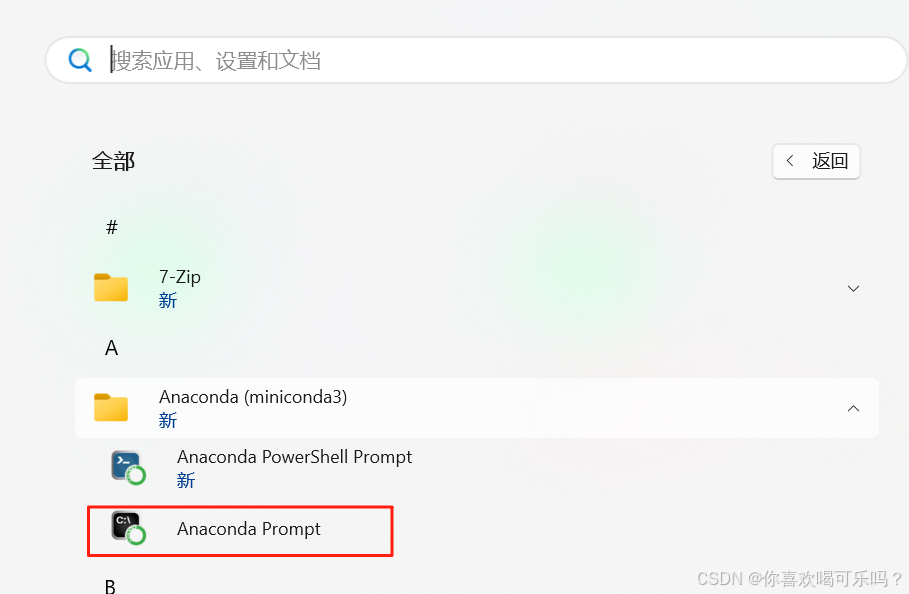
Windows安装Miniconda
一、下载 https://www.anaconda.com/download/success 二、安装 三、配置镜像源 Anaconda/Miniconda pip 配置清华镜像源_anaconda配置清华源-CSDN博客 四、常用操作命令 Anaconda/Miniconda 基本操作命令_miniconda创建环境命令-CSDN博客...

解决:Android studio 编译后报错\app\src\main\cpp\CMakeLists.txt‘ to exist
现象: android studio报错: [CXX1409] D:\GitLab\xxxxx\app.cxx\Debug\3f3w4y1i\arm64-v8a\android_gradle_build.json : expected buildFiles file ‘D:\GitLab\xxxxx\app\src\main\cpp\CMakeLists.txt’ to exist 解决: 不要动CMakeLists.…...

